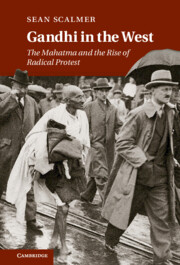4 - Waiting for the peace train
Published online by Cambridge University Press: 03 May 2011
Summary
How to move from the printed page to the jostling crowd? From the pulpit to the public square? From thought to action? What form would satyagraha take on the dusty plains of America or in the foggy laneways of London town? Would John Bull ever turn the other cheek? What about the Studs Lonigan of Chicago's street corners? Or the hard-bitten denizens of the Gothamite metropolis?
Westerners impressed by Gandhi's way struggled with these questions from the onset of Depression through to the middle of the century. Would-be Gandhians were a significant presence in the largest pacifist institutions of the West: the Fellowship of Reconciliation (FoR – an interfaith organisation present on both sides of the Atlantic) and the Peace Pledge Union (PPU – Britain's largest pacifist group). They were also active members of other campaigns: agitators for civil rights, opponents of animal cruelty, champions of the unemployed. Their political efforts were not simply experiments with satyagraha, but attempts to advance a particular cause. In consequence, their struggles were sometimes dispersed and their histories usually told in the separate chronicles of institutions and campaigns.
The breadth of their social concerns should not distract from the commonality of their method. They were the joint exponents of Gandhism in the West. The following pages tell the story of satyagraha's would-be Western pioneers over the fourth and fifth decades of the last century. It was a period spanning economic collapse, political instability, and world war.
- Type
- Chapter
- Information
- Gandhi in the WestThe Mahatma and the Rise of Radical Protest, pp. 105 - 136Publisher: Cambridge University PressPrint publication year: 2011



